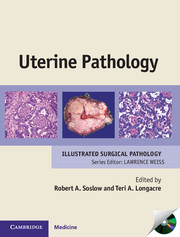Book contents
- Frontmatter
- Contents
- List of contributors
- Preface
- Acknowledgments
- 1 Cytology of the uterine cervix and corpus
- 2 Cervix: squamous cell carcinoma and precursors
- 3 Cervix: adenocarcinoma and precursors, including variants
- 4 Miscellaneous cervical abnormalities
- 5 Non-neoplastic endometrium
- 6 Endometrial carcinoma precursors: hyperplasia and endometrial intraepithelial neoplasia
- 7 Endometrioid adenocarcinoma
- 8 Serous adenocarcinoma
- 9 Clear cell adenocarcinoma and other uterine corpus carcinomas, including unusual variants
- 10 Carcinosarcoma
- 11 Adenofibroma and adenosarcoma
- 12 Uterine smooth muscle tumors
- 13 Endometrial stromal tumors
- 14 Other uterine mesenchymal tumors
- 15 Miscellaneous primary uterine tumors
- 16 Uterine metastases: cervix and corpus
- 17 Gestational trophoblastic disease
- 18 Other pregnancy-related abnormalities
- 19 Lynch syndrome (hereditary non-polyposis colorectal cancer syndrome)
- 20 Cytology of peritoneum and abdominal washings
- Index
- References
11 - Adenofibroma and adenosarcoma
Published online by Cambridge University Press: 05 July 2013
- Frontmatter
- Contents
- List of contributors
- Preface
- Acknowledgments
- 1 Cytology of the uterine cervix and corpus
- 2 Cervix: squamous cell carcinoma and precursors
- 3 Cervix: adenocarcinoma and precursors, including variants
- 4 Miscellaneous cervical abnormalities
- 5 Non-neoplastic endometrium
- 6 Endometrial carcinoma precursors: hyperplasia and endometrial intraepithelial neoplasia
- 7 Endometrioid adenocarcinoma
- 8 Serous adenocarcinoma
- 9 Clear cell adenocarcinoma and other uterine corpus carcinomas, including unusual variants
- 10 Carcinosarcoma
- 11 Adenofibroma and adenosarcoma
- 12 Uterine smooth muscle tumors
- 13 Endometrial stromal tumors
- 14 Other uterine mesenchymal tumors
- 15 Miscellaneous primary uterine tumors
- 16 Uterine metastases: cervix and corpus
- 17 Gestational trophoblastic disease
- 18 Other pregnancy-related abnormalities
- 19 Lynch syndrome (hereditary non-polyposis colorectal cancer syndrome)
- 20 Cytology of peritoneum and abdominal washings
- Index
- References
Summary
INTRODUCTION
The adenofibroma–adenosarcoma spectrum of biphasic mullerian tumors in the female gynecologic tract resembles the fibroadenoma–phyllodes spectrum in the breast. As in the breast, zones of histologic overlap exist and, on occasion, areas of adenofibromatous and adenosarcomatous differentiation may be seen in the same neoplasm. Classification of these tumors is ultimately based on the most histologically malignant area, but it should not be surprising that, just as there are gradations of histologic malignancy amongst these tumors, gradations of clinical behavior may also occur. However, unlike the situation in the breast, most (some authorities have maintained all) of these biphasic tumors in the uterus fall well within the low-grade sarcoma spectrum. In contrast, adenofibromas, if they exist, are clinically benign with little risk for recurrence once they are completely excised.
ADENOSARCOMA
Adenosarcoma is uncommon; it is a predominantly low-grade malignant tumor that is composed of sarcomatous stroma and benign epithelial elements. This tumor often represents a challenge for the pathologist due to significant overlap with benign polyps on the one hand and with carcinosarcoma and sarcoma entrapping benign glands on the other. Indeed, the low-grade forms of adenosarcoma account for a significant proportion of malignant lesions within the female genital tract and peritoneum that are underdiagnosed by pathologists.
Most adenosarcomas occur in the uterine corpus, but they may arise in cervical, vaginal, tubal, ovarian, and peritoneal sites. Involvement of additional extragenital sites in women has been linked to endometriosis. An association with unopposed estrogen and tamoxifen therapy has been reported in uterine adenosarcoma.
- Type
- Chapter
- Information
- Uterine Pathology , pp. 205 - 218Publisher: Cambridge University PressPrint publication year: 2012



